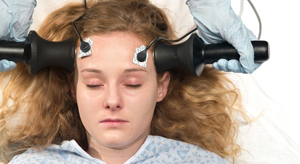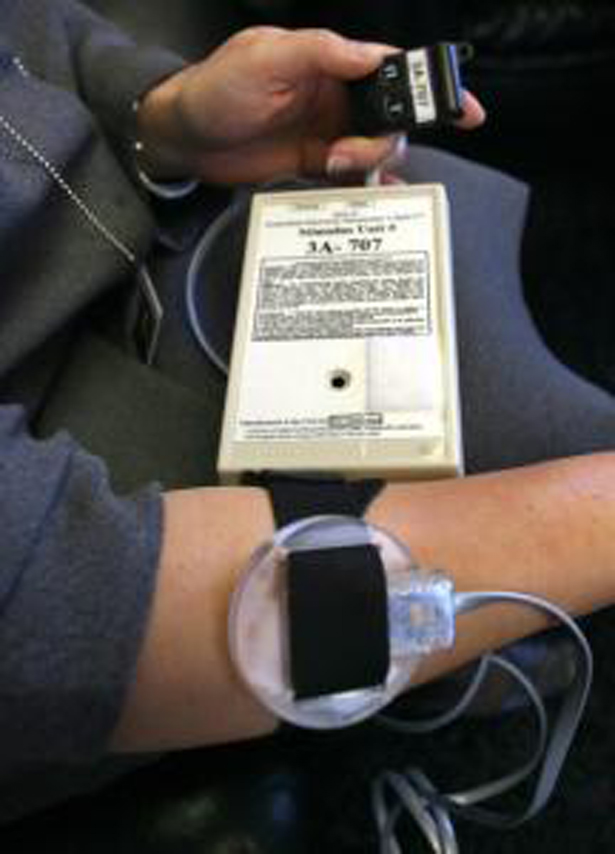By CCHR International
The Mental Health Industry Watchdog
April 28, 2016
The Food and Drug Administration has proposed banning devices that use painful electric shocks as punishment to intellectually disabled children, youths and adults.[1] One of them, called a “Graduated Electronic Decelerator (GED),” delivers multiple shocks to the skin—different to the Electroconvulsive Therapy (ECT) device, which uses voltage that is 660% greater than the GED and is applied to the head. But the GED, developed at and used by the Judge Rotenberg Educational Center (JRC) in Canton, Massachusetts, is as controversial as ECT, with the FDA saying the GED presents “an unreasonable and substantial risk of illness or injury to the public.”[2]
However, while the FDA plans on banning ESD and other “Electrical Stimulation Devices”—a long overdue but commendable action—this doesn’t include the ECT device used to treat so-called mental disorders. Under apparent influence from members of the American Psychiatric Association (APA), the FDA still allows the ECT device to be used on children and adolescents.[3]
The FDA is seeking public comment on the GED device until May 25, 2016. Citizens Commission on Human Rights says that those concerned especially with children’s rights, should write the FDA to support a ban on both the GED and ECT devices.

The GED device was originally developed by JRC Founder, Matthew Israel, a Harvard-trained psychologist who in 2011 was forced to step down from JRC after criminal charges were brought against him
The GED device was originally developed by JRC Founder, Matthew Israel, a Harvard-trained psychologist who in 2011 was forced to step down from JRC after criminal charges were brought against him relating to an incident in August 2007. A call came in from someone posing as an authorized supervisor, who informed staff that two teenagers had misbehaved and should be given shock treatment. At 2am, the boys were strapped on boards and given multiple shocks. One of the boys, aged 18, was shocked 77 times over a three-hour period and the other boy, aged 16, was shocked 29 times. It was later discovered that the initial call had been a hoax. Israel was forced to quit the institution and serve five years’ probation. [4]
However, the violent and punishing electroshocks continued at JRC, forcing the United Nations’ special rapporteur on torture, Juan E. Méndez, in 2013 to report that its “skin shocks” to ‘treat’ people with mental disorders or developmental disabilities was “torture.”[5] Mendez, a Professor of Human Rights Law, also defined procedures such as electroconvulsive therapy without the consent of the patient as a form of torture. He called upon states to “Impose an absolute ban on all forced and non-consensual medical interventions against persons with disabilities, including the non-consensual administration of psychosurgery, electroshock and mind-altering drugs….”[6]
Comparison between GED and ECT
Here’s some facts about the two devices—GED and ECT.
GED: Electrodes emit 60 volts and 15-45.5 milliamps of electrical current in two-second bursts. The electrodes are attached to the arms, legs, or stomachs of students. [7] It is much stronger than police stun guns (1-4 milliamps). Unlike stun guns, the electrodes most commonly used are spaced 3 – 4 inches apart so that the electrical volts passing through the flesh create the maximum amount of pain with those amps and volts.[8]

In ECT, electrodes are placed on one side of the head or on both temples and emit up to 460 volts through the brain.
ECT: Electrodes are placed on one side of the head or on both temples and emit up to 460 volts (666% higher than that used in a GED) and between 550 and 1,000 milliamps (depending on the shock machine). [9] This is between 3,500% and more than 6,500% greater than the milliamps emitted by the GED. This electricity produces a seizure that lasts about 60 seconds.[10] Electrodes deliver the electricity through the skull into the brain. However, the skull has sensitive nerve endings on the outside, which is why we learn early not to bang it into hard objects.[11] ECT devices have been “updated” over the years but these have never passed clinical trials approved by the FDA.
GED: Six children are reported to have died in the care of the Judge Rotenberg Center, “prompting numerous lawsuits and government investigation.”[12] While it is unknown if these were the result of the GED being used, Amnesty International has reported that Taser shocks generally (which use fewer milliamps than GEDs) may be implicated in the deaths of more than 150 people between 2001 and 2006 and coroners have cited stun-gun shocks [to the skin] as a factor in more than 20 deaths over that period. Once the electrodes hit their target, the Taser sends a pulse with about 50,000 volts. Temporary paralysis can set in, and most victims fall to the ground.[13]
ECT: Uses up to 1,000 milliamps, although far less voltage than a Taser. Yet 1/10 of an ampere of electricity going through the body for just 2 seconds is enough to cause death.[14] The APA and FDA do not keep statistics on ECT deaths—only arbitrary extrapolations, although the FDA reported in 2011 that death was a risk of the ECT device.[15]
GED: In 2012, the FDA warned the Judge Rotenberg Center about the GED devices, saying that they violated FDA regulations. It was the third time the FDA had contacted the center. In 2011 and earlier in 2012, the agency informed the center that because of changes made to the device, the Judge Rotenberg Center would need to file a new approval application. The changes in question involved increasing the voltage since the 1994 approval of the zapper, putting the device out of compliance.[16]
ECT: Since 1978, the FDA has failed to ensure that the ECT device makers provided approval applications to ensure safety and efficacy. In 1979, the FDA classified the ECT device as Class III, demonstrating “an unreasonable risk of illness or injury.” The manufacturer was required to provide a marking application, with clinical trials by April 1982. They failed to do this and the FDA failed to enforce its order.[17] On August 10, 1982, the APA filed a petition to have the device classified as a less risk Class II device based on its own selective review of literature. [18] The device has remained Class III. Despite this, psychiatrists administered electroshock to children—even today. In 2016, the APA again asked the FDA to reduce the high-risk ECT device so that more people could be subjected to it, including children.
GED: In a 2014 FDA report, investigators said they learned of burns, scars, muscle spasms, seizures and other effects from those who received the skin shocks. Former Rotenberg Center students told the agency that the experience left them “fearful” and “anxious.”[19]
ECT: The FDA reports that Electroshock can cause skin burns, physical trauma (including fractures, contusions, injury from falls, dental and oral injury), prolonged or delayed onset seizure and complications, including heart attack and even death. [20]

“It’s not humane, you don’t even feel like a person, you have wires all over your body…I would get five or ten shocks….” — Jennifer Msumba, JRC resident
GED: “It’s not humane, you don’t even feel like a person, you have wires all over your body…I would get five or ten shocks….” “It’s so scary. I would ask God to make my heart stop because I didn’t want to live when that was happening to me. I just wanted to die and make it stop.” – Jennifer Msumba, former resident of JRC.[21]
ECT: “As a result of the ECT treatments…my wife’s memory has been greatly impaired….Although she spoke English as a second language for 42 years, she has lost most of her ability to speak and understand it….The whole experience has been a deception, a lie, a bully’s punch….Her depression was not cured and her memory is defective now.” – Husband’s account of his wife’s ECT
The FDA’s failure to protect individuals, especially children, from all forms of “therapeutic” electroshock warrants an investigation, in particular into why it is listening to psychiatrists that advocate this as “treatment,” not torture. For over 20 years Massachusetts state legislators authored bills attempting to ban JRC’s use of skin shocks and failed. In 2008, Massachusetts legislators likened the JRC to Abu Ghraib. “If we tried to apply this brutal device to a prisoner in Guantanamo or someone in Abu Ghraib, there would be worldwide outrage,” said state Senator Brian A. Joyce in 2008, whose district included the school’s Canton site. “In fact, it’s against the Eighth Amendment in our country, right? Cruel and unusual punishment. But we allow it for these innocent children. It’s just not right.”[22]
CCHR says “It’s just not right” that any child be subjected to any form of electroshock “therapy” whether it’s to forcibly change aggressive or self-injurious behavior or change their emotional or mental trauma. The bottom line is that is “cruel and unusual punishment” and both the GED and ECT devices should be prohibited.
 CCHR is a non-profit, public benefit organization.
CCHR is a non-profit, public benefit organization.
References:
[1]“Judge Rotenberg Center Survivor’s Letter,” 15 January 2015, http://www.autistichoya.com/2013/01/judge-rotenberg-center-survivors-letter.html.
[2] Paul Kix, “The Shocking Truth,” The Boston Globe, July 2008, http://www.bostonmagazine.com/articles/2008/06/the-shocking-truth/; Glenn Elert, “Voltage of Electroshock Therapy,” accessed Apr 28, 2016, http://hypertextbook.com/facts/2005/GinaCastellano.shtml, citing: Null, Gary (Ph.D.) “The Hidden Side of Psychiatry: Electroconvulsive Therapy.” Say No to Psychiatry (SNTP), 1999; “FDA proposes ban on electrical stimulation devices intended to treat self-injurious or aggressive behavior,” FDA.gov, April 22, 2016, http://www.fda.gov/NewsEvents/Newsroom/PressAnnouncements/ucm497194.htm.
[3] “Banned Devices; Proposal to Ban Electrical Stimulation Devices Used to Treat Self-Injurious or Aggressive Behavior” Regulations.gov, Docket ID: FDA-2016-N-1111, April 25, 2016, https://www.regulations.gov/#!docketDetail;D=FDA-2016-N-1111, APA Supports ECT Device Reclassification; File Your Comments Now,” Psychiatric News Alert, March 11, 2016, http://alert.psychnews.org/2016/03/apa-supports-ect-device.html.
[4] “Founder of electric shock autism treatment school forced to quit: Institute uses punishment machine to discipline severely autistic and emotionally disturbed children by giving them electric shocks,” The Guardian, 25 May 2011, http://www.theguardian.com/world/2011/may/25/electric-shock-autism-treatment-school.
[5] Emily Willingham, “Autism Shock Therapy Practiced in US Is Torture, Says UN Official,” Forbes, 8 Mar. 2013, http://www.forbes.com/sites/emilywillingham/2013/03/08/autism-shock-therapy-is-torture-says-un-official/#388d11c64fc2.
[6] A/HRC/22/53, “Report of the Special Rapporteur on torture and other cruel, inhuman or degrading treatment or punishment, Juan E. Méndez,” United Nations, General Assembly, Human Rights Council, Twenty-second Session, Agenda Item 3, 1 Feb. 2013, p. 21, para 85, http://www.ohchr.org/Documents/HRBodies/HRCouncil/RegularSession/
Session22/A.HRC.22.53_English.pdf.
[7]Paul Kix, “The Shocking Truth,” The Boston Globe, July 2008, http://www.bostonmagazine.com/articles/2008/06/the-shocking-truth/ Lydia Brown, “It’s illegal to torture prisoners and animals, but not disabled people,” The Washington Post, 22 July 2014, https://www.washingtonpost.com/posteverything/wp/2014/07/22/its-illegal-to-torture-prisoners-and-animals-but-not-disabled-people.
[8] Yukio Strachan, “School tortures autistic boy with electric shocks, staff laughs,” Digital Journal, May 6, 2012, http://www.digitaljournal.com/article/324352.
[9] https://ectstatistics.wordpress.com/2011/04/27/electroconvulsive-therapy-how-many-amps/; The Brain Stimulation Clinic, Atlanta, Georgia, http://www.transcranialbrainstimulation.com/; “Ronald L. Warnell, MD, Conrad M. Swartz, PhD, MD ET A;, “Clinically insubstantial cognitive side effects of bitemporal electroconvulsive therapy at 0.5 msec pulse width,” Annals of Clinical Psychiatry, 2011: 23 (4): 257-262, https://aacp.com/pdf%2F1111%2F1111ACP_Warnell.pdf.
[10] http://psychcentral.com/lib/what-to-expect-from-an-electroconvulsive-therapy-ect-treatment/.
[11] http://www.ect.org/effects/testimony.html.
[12] http://dredf.org/pdfs/Letter-from-Disability-Rights-Advocates-Sept-09.pdf.
[13] Daniel Engber, “How do Tasers Work,” Slate, 21 Nov. 2006, http://www.slate.com/articles/news_and_politics/explainer/2006/11/how_do_tasers_work.html.
[14] https://sciencebasedlife.wordpress.com/2012/02/02/how-much-voltage-can-you-take-on-before-you-die/.
[15] http://www.fda.gov/downloads/MedicalDevices/…/UCM478942.pdf, pp. 18-19.
[16] Emily Willingham, “FDA Proposes Ban On Electric Shock Devices Used On Autistic Children,” Forbes, 22 Apr. 2016, http://www.forbes.com/forbes/welcome/.
[17] Am J. Psychiatry 138:4, April 1981, p. 572.
[18] FDAdocket 82P-0316/F820007.
[19] Michelle Diament, “FDA Moves To Ban Shock Devices Used On Those With Special Needs,” Disability Scoop, April 22, 2016, https://www.disabilityscoop.com/2016/04/22/fda-moves-ban-shock-devices/22216/.
[20] http://www.fda.gov/downloads/MedicalDevices/…/UCM478942.pdf, pp. 18-19.
[21] “Controversy over shocking people with autism, behavioral disorders,” CBS News, 5 Aug. 2014, http://www.cbsnews.com/news/controversy-over-shocking-people-with-autism-behavioral-disorders/.
[22] Paul Kix, “The Shocking Truth,” The Boston Globe, July 2008, http://www.bostonmagazine.com/articles/2008/06/the-shocking-truth/.


